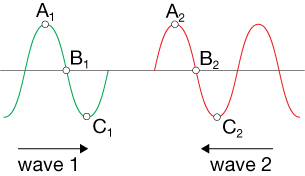Module 8—Mechanical Waves
 Explore
Explore

© Jenny Solomon/shutterstock
Although sound waves are longitudinal waves, they will be represented as transverse waves for the purposes of illustration. In this sense, sound waves behave in a similar way to water waves, as seen in the photo to the right. Imagine two point sources that produce identical waves that run into one another. Recall from previous lessons that when two wave fronts meet, they combine according to the principle of superposition (the displacement of a given particle is equal to the sum of the displacements that would have been produced by each wave acting independently). The waves combine in three possible ways—constructively (in phase), destructively (out of phase), or somewhere in between (intermediate).
 Watch and Listen
Watch and Listen
Watch this interference video clip to observe the interference pattern produced by two point sources.
 Module 8: Lesson 5 Assignment
Module 8: Lesson 5 Assignment
Remember to submit the answer to TR 1 to your teacher as part of your Module 8: Lesson 5 Assignment.
 Try This
Try This
TR 1. The diagram below shows two waves moving towards each other. For each of the following combinations, circle whether the interference will be constructive (C), destructive (D), or intermediate (I). For example, when point A1 meets point C2, the wave will destructively interfere, producing no amplitude.

a. A1 and A2 |
C |
D |
I |
e. B1 and C2 |
C |
D |
I |
b. A1 and B2 |
C |
D |
I |
f. C1 and A2 |
C |
D |
I |
c. A1 and C2 |
C |
D |
I |
g. C1 and B2 |
C |
D |
I |
d. B1 and A2 |
C |
D |
I |
h. C1 and C2 |
C |
D |
I |
path difference: the difference between two path lengths
path length: the distance between a source and an observer
You answered TR 1 using the concept that interference depends on the phase relationship between waves. You can think of the phase relationship in terms of path difference. To reach a common point, the wave fronts must each travel a certain path length, L. When two wave paths are compared and are found to travel different lengths, then a path difference, ΔL, exists. You will use a simulation to investigate how path difference relates to interference.